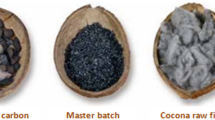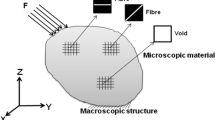The effect of addition of carbon fibers and wollastonite on the mechanical properties of graphite/asphalt/Cu composites is described. The gene expression programming method is used to predict the effects of fillers on their properties. A multiconstraint optimization problem is solved, and the optimum composition is determined.


Similar content being viewed by others
References
N. A. Radzuan, M. Y. Zakaria, and A. B. Sulong, “The effect of milled carbon fibre filler on electrical conductivity in highly conductive polymer composites,” Composites: Part B, 110, 153-160 (2017).
A. B. Sulong, M. I. Ramli, and S. L. Hau, “Rheological and mechanical properties of carbon nanotube/graphite/SS316L/ polypropylene nano-composite for a conductive polymer composite,” Composites: Part B, 50, 54-61 (2013).
X. W. Zhao, C. G. Zang, and Q. K. Ma, “Thermal and electrical properties of composites based on (3-mercaptopropyl) trimethoxysilane and Cu-coated carbon fiber and silicone rubber,” J. Mater. Sci., 51, N. 8, 1-8 (2016).
J. Z. Liang, B. Li, J. and Q. Ruan, “Crystallization properties and thermal stability of polypropylene composites filled with wollastonite,” Polymer Testing, 42, 185-191 (2015).
J. H. Yu, C. Li, and Q. S. Yao, “Study on the performance of wollastonite modified PTFE composite material,” Adv. Mater. Res., 1089 (2014).
J. N. Panda, J. Bijwe, and R. K. Pandey, “Role of treatment to graphite particles to increase the thermal conductivity in controlling tribo-performance of polymer composites,” Wear, 360, 87-96 (2016).
M. Y. Zakaria, A. B. Sulong, and J. Sahari, “Effect of the addition of milled carbon fiber as a secondary filler on the electrical conductivity of graphite/epoxy composites for electrical conductive material,” Composites: Part B, 83, 75-80 (2015).
M. C. Hsiao, S. H. Liao, and M. Y. Yen, “Effect of graphite sizes and carbon nanotubes content on flow ability of bulk-molding compound and formability of the composite bipolar plate for fuel cell,” J. Power Sources, 195, No. 17, 5645-5650 (2010).
C. J. Tu, D. Chen, and Z. H. Chen, “Improving the tribological behavior of graphite/Cu matrix self-lubricating composite contact strip by electroplating Zn on graphite,” Tribology Let., 31, No. 2, 91-98 (2008).
C. J. Tu, Z. Chen, and J. Xia, “Thermal wear and electrical sliding wear behaviors of the polyimide modified polymermatrix pantograph contact strip,” Tribology Int., 42, No. 6, 995-1003 (2009).
B. C. D. Luan, J. Huang, and J. Zhang, “Enhanced thermal conductivity and wear resistance of polytetrafluoroethylene composites through boron nitride and zinc oxide hybrid fillers,” J. Appl. Polymer Sci., 132, No. 30 (2015).
C. Zhang, J. Song, and L. Jiang, “Fabrication and tribological properties of WC-TiB 2 composite cutting tool materials under dry sliding condition,” Tribology Int., 109, 97-103 (2017).
J. Yuan, Z. Zhang, and M. Yang, “Surface modification of hybrid-fabric composites with amino silane and polydopamine for enhanced mechanical and tribological behaviors,” Tribology Int., 107, 10-17 (2017).
T. Gurunathan, C. R. K. Rao, and R. Narayan, “Polyurethane conductive blends and composites: synthesis and applications perspective,” J. Mater. Sci., 48, No. 1, 67-80 (2013).
D. S. Mclachlan, “An equation for the conductivity of binary mixtures with anisotropic grain structures,” J. Physics C Solid State Physics, 20, No. 7, 865 (2000).
D. S. Mclachlan, M. Blaszkiewicz, and R. E. Newnham, Electrical resistivity of composites,” J. Am. Ceramic Soc., 73, No. 8, 2187-2203 (2010).
M. Müller and G. P. Ostermeyer, “A cellular automaton model to describe the three-dimensional friction and wear mechanism of brake systems,” Wear, 263, Nos. 7-12, 1175-1188 (2007).
A. Mazahery and M. O. Shabani, “Assistance of novel artificial intelligence in optimization of aluminum matrix nanocomposite by genetic algorithm,” Appl. Optics, 43, No. 13, 5279-5285 (2012).
M. O. Shabani, M. R. Rahimipour, and A. A. Tofigh, “Refined microstructure of compo cast nanocomposites: the performance of combined neuro-computing, fuzzy logic and particle swarm techniques,” Neural Computing & Applications, 26, No. 4, 899-909 (2014).
M. O. Shabani, A. Mazahery, M. R. Rahimipour, The most accurate ANN learning algorithm for FEM prediction of mechanicsal performance of alloy A356, KovoveMaterialy, 2012, 50(1):25-31.
A. Ramil, A. J. López, and A. Yáñez, “Application of artificial neural networks for the rapid classification of archaeological ceramics by means of laser induced breakdown spectroscopy (LIBS),” Appl. Physics A, 92, No. 1, 197-202 (2008).
A. Mazahery and M. O. Shabani, “Development of the principle of simulated natural evolution in searching for a more superior solution: Proper selection of processing parameters in AMCs,” Powder Technol., 245, No. 8, 146-155 (2013).
U. Aich and S. Banerjee, “Modeling of EDM responses by support vector machine regression with parameters selected by particle swarm optimization,” Appl. Math. Modelling, 38, No. 11-12, 2800-2818 (2014).
M. O. Shabani and A. Mazahery, “Computational modeling of cast aluminum 2024 alloy matrix composites: Adapting the classical algorithms for optimal results in finding multiple optima,” Powder Technol., 249, No. 2, 77-81 (2013).
C. Ferreira, “Gene expression programming: a new adaptive algorithm for solving problems,” Computer Sci., No. 2. 87-129 (2001).
C. Ferreira, Gene Expression Programming: Mathematical Modeling by an Artificial Intelligence, Springer Ebooks (2006).
A. Baykasoğlu, H. Güllü, and H. Çanakçı, “Prediction of compressive and tensile strength of limestone via genetic programming,” Expert Systems with Applications, 35, No. 1-2, 111-123 (2008).
Author information
Authors and Affiliations
Corresponding author
Additional information
Russian translation published in Mekhanika Kompozitnykh Materialov, Vol. 54, No. 5, pp. 995-1006, September-October, 2018.
Rights and permissions
About this article
Cite this article
Wu, J., Huang, Z.C., Luo, N. et al. Investigation of Carbon Fiber- and Wollastonite-Filled Graphite/Asphalt/Cu Composite Materials Using the Gene Expression Programming. Mech Compos Mater 54, 685–694 (2018). https://doi.org/10.1007/s11029-018-9776-y
Received:
Revised:
Published:
Issue Date:
DOI: https://doi.org/10.1007/s11029-018-9776-y




